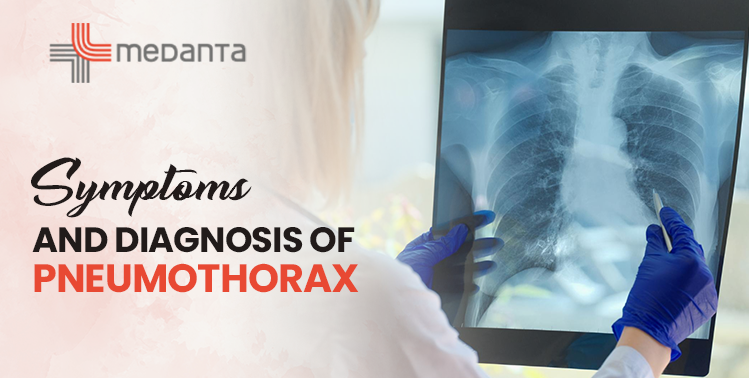CH Baktawar Singh Rd, Medicity, Islampur Colony, Sector 38, Gurugram, Haryana 122001

20 March, 2025
Kashmera hazraPneumothorax, commonly known as a collapsed lung, is a condition where air leaks into the space between the lung and the chest wall, leading to the collapse of part or all of a lung. Although it might sound alarming, pneumothorax can often be managed effectively, especially when diagnosed early. In this blog, we will explore the symptoms and diagnosis of pneumothorax, helping you understand how this condition is detected and treated.
The lungs are surrounded by a thin layer of tissue called the pleura, which consists of two layers: the visceral pleura, which covers the lungs, and the parietal pleura, which lines the chest wall. Pneumothorax occurs when air enters the pleural cavity, causing a portion of the lung to collapse. This can be a result of trauma, medical procedures, or it can occur spontaneously without any obvious cause.
The symptoms of pneumothorax can vary based on the size of the collapse, the type of pneumothorax, and the underlying health of the patient. Some individuals may experience mild symptoms, while others may suffer from more severe discomfort. The most common symptoms include:
The severity of symptoms can depend on the size of the pneumothorax and whether it is a primary or secondary type. In some cases, people with a small pneumothorax may not experience symptoms at all, or their symptoms may resolve on their own.
Several factors increase the likelihood of developing pneumothorax:
Diagnosing pneumothorax involves a combination of medical history review, physical examination, and imaging tests. Here’s a breakdown of how pneumothorax is typically diagnosed:
The first step in diagnosing pneumothorax is a thorough evaluation of the patient’s symptoms and medical history. The doctor will ask about recent chest injuries, underlying lung diseases, or spontaneous symptoms. A physical examination will also be conducted to check for signs such as:
The doctor will also ask the patient about any recent activities that may have triggered the symptoms, such as vigorous exercise or coughing.
The most common imaging technique used to confirm the presence of pneumothorax is a chest X-ray. It allows the doctor to visualize the lung and the amount of air in the pleural space. In cases of pneumothorax, the X-ray will show a visible gap between the lung and the chest wall, indicating the presence of air.
In more complicated cases or when the chest X-ray does not provide sufficient information, a CT scan may be performed. A CT scan provides a more detailed image of the lungs and pleural space, making it easier to detect even small pneumothoraces or underlying lung diseases.
In some cases, especially in emergency settings, a chest ultrasound may be used. Ultrasound is a quick and non-invasive way to assess the size of the pneumothorax and help guide further management, such as the placement of a chest tube.
If the pneumothorax is large or causing significant breathing difficulty, an arterial blood gas (ABG) test may be performed to assess the oxygen levels in the blood and determine the severity of the condition.
Pneumothorax is a serious but treatable condition that can range from mild to life-threatening. Recognizing the symptoms early and seeking medical attention can lead to effective management and a positive outcome. If you experience sudden chest pain, shortness of breath, or other related symptoms, it’s crucial to seek medical attention immediately. With the right diagnosis and treatment, most individuals with pneumothorax can recover fully and resume normal activities.
If you or a loved one are experiencing symptoms of pneumothorax, consult with a thoracic surgeon or a medical professional for proper evaluation and care.
Category : Pneumothorax
Tags: